COOPERATION MODEL
ARTIFICIAL INTELLIGENCE
PRODUCT ENGINEERING
DevOps & Cloud
LOW-CODE/NO-CODE DEVELOPMENT
FRONTEND DEVELOPMENT
CLOUD DEVELOPMENT
MOBILE APP DEVELOPMENT
LOW CODE/ NO CODE DEVELOPMENT
EMERGING TECHNOLOGIES







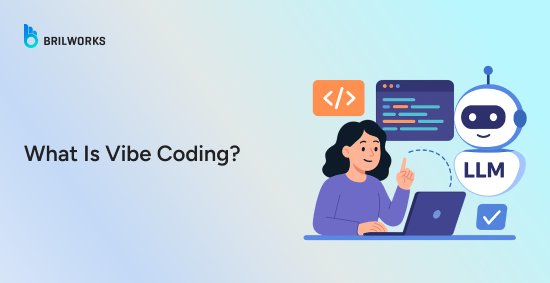
Coined by AI researcher Andrej Karpathy in early 2025, vibe coding describes a workflow where a developer or a non-technical person, uses a large language model (LLM) to "blink software into reality." Instead of writing syntax, the user describes the desired outcome in plain English, and the AI generates the corresponding code. The user's primary role becomes one of a director or prompt engineer, who tests the AI's output and refines it through continuous feedback.
The process of vibe coding is a continuous loop of:
Prompting: You describe what you want in natural language (e.g., "Create a Python script that reads a CSV file and plots a bar chart.").
Generating: The AI interprets your request and produces the initial code.
Executing and Refining: You run the generated code to see if it works as intended. If it doesn't, or if you want to add more features, you provide new instructions (e.g., "That works, but add error handling for when the file is not found.").
Iterating: This conversational cycle of describing, generating, testing, and refining continues until the desired result is achieved.
Vibe coding is not just an evolution of AI-assisted tools like GitHub Copilot, which primarily auto-completes code snippets. It represents a fundamental shift in the development paradigm.
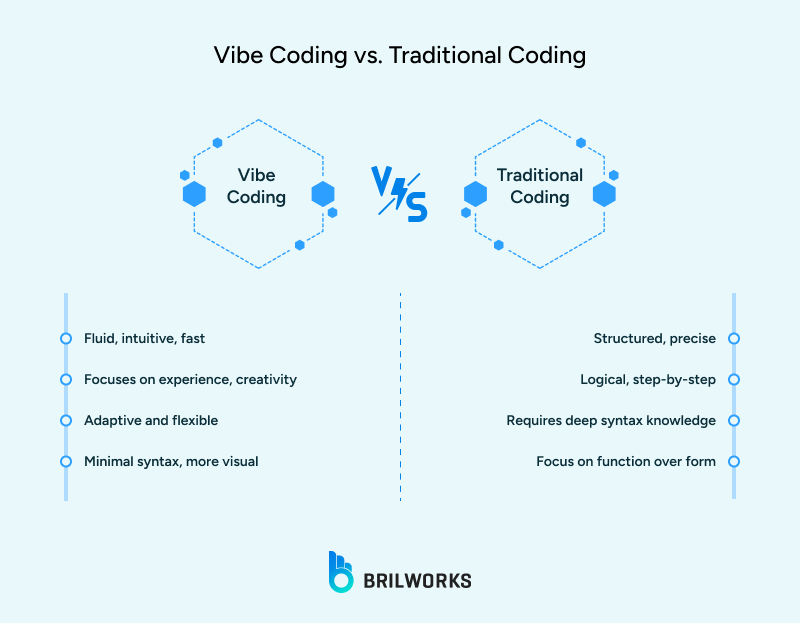
Vibe coding is popular in startups with highest adoption rate, fast-paced digital agencies, and tech-driven enterprises. Large corporates use it mostly for prototyping and MVPs, while more highly regulated industries are slower to implement.
Big names like Amazon, Google, Microsoft, Meta, and Visa now report that 20–50% of their new code is AI-generated, mixing vibe coding and copilot approaches. In his discussion with Satya Nadella on YouTube, Mark Zuckerberg said he believes AI could soon handle around half of all programming tasks. (Source: YouTube/Business Today)
About 40% of small businesses use generative VI/AI coding tools, with higher profitability and quicker hiring cycles than peers who do not use these tools. Regulated industries are more conservative, with lower adoption rates.
Recent Stack Overflow 2025 developer trends survey note that most professional developers have not made vibe coding their main workflow—about 28% use it centrally, 72% still treat it as an auxiliary tool.
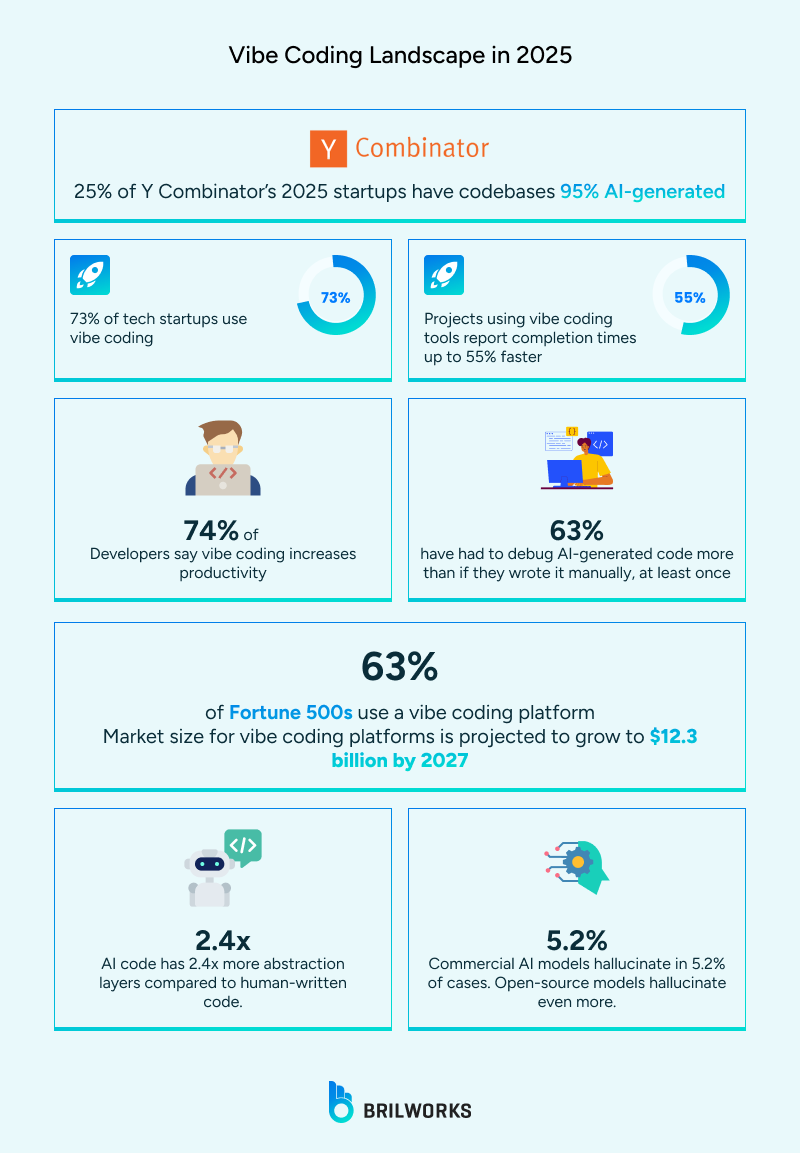
Starting with vibe coding is a practical way to begin leveraging AI for software development for developers. Here’s how you can start vibe coding.
First, you need a tool that's built for this workflow. While you can use a general-purpose chatbot like ChatGPT, dedicated vibe coding tools offer a better experience. Here are some popular options:
For Beginners: Tools like Replit and Lovable are great starting points. They offer a simple, browser-based environment where you can write a natural language prompt, and the AI generates and runs the code with a live preview. They handle the complex setup for you, so you can focus on learning the process.
For Developers: If you're already familiar with a code editor, an AI-native IDE like Cursor is an excellent choice. It's a fork of VS Code, so it will feel familiar, but it has deeper AI integrations that can read your entire codebase.
Don't try to build an entire app on your first try. The best way to learn is by tackling small, self-contained projects. This allows you to understand the full vibe coding loop without getting overwhelmed.
The "vibe" in vibe coding comes from the conversational, iterative process. The quality of your output is directly tied to the clarity and detail of your prompts.
Be Specific: Instead of a vague request like "build an app," be detailed. For example, "Create a webpage with a dark blue background, a centered heading that says 'My First Vibe Code Project,' and a button that shows an alert when clicked."
Break It Down: Avoid giving a huge, complex request in a single prompt. Break your project down into smaller, manageable steps.
Step 1: "Create an HTML file with a basic structure."
Step 2: "Add a CSS section to make the background color dark blue and center the text."
Step 3: "Add a button that has a specific text and a click event."
Provide Context: If you're working on a larger project, remind the AI of the key information. For instance, "I'm working on a React app. Add a new component called JokesList that fetches jokes from this API: [API URL]."
Debug with Prompts: When you get an error, copy and paste the error message directly into the chat and ask the AI to fix it. This is a powerful way to debug without manually searching for solutions.
Even with advanced AI, human oversight is critical. The most successful vibe coding workflows are a collaboration between human and AI.
For business leaders, vibe coding offers a compelling value proposition that goes beyond simple developer productivity.
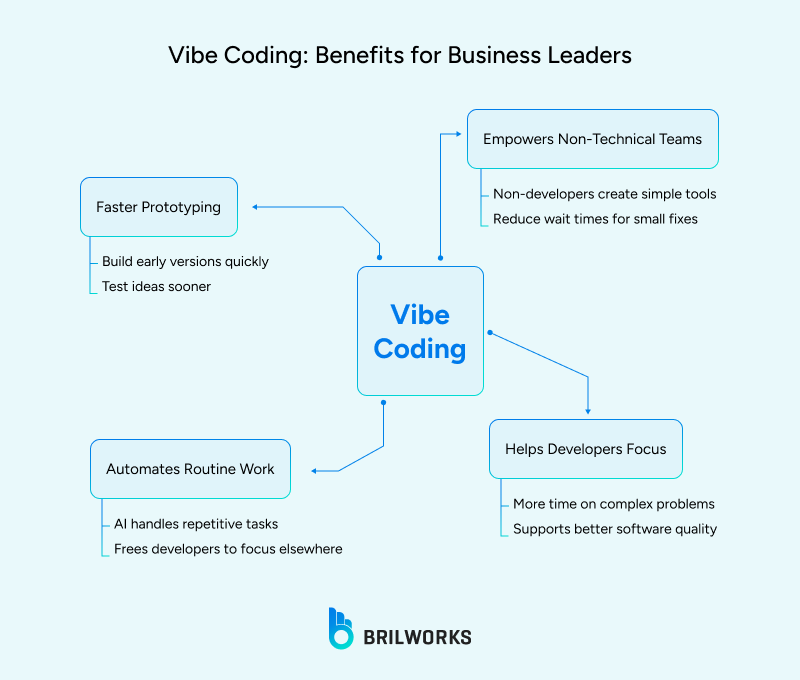
Faster MVPs and Time-to-Market: It drastically reduces the time to go from an idea to a working prototype. Startups can validate concepts in a matter of hours or days, not weeks or months. This allows for rapid experimentation and a significant competitive advantage.
Democratized Development: By enabling non-technical employees like product managers, designers, or marketers, to build their own internal tools and automations, vibe coding unlocks a new layer of innovation across the entire organization.
Cost Efficiency: Automating boilerplate and repetitive tasks with AI reduces development time, leading to lower project costs and more efficient resource allocation.
Amplified Developer Productivity: Vibe coding doesn't necessarily replace developers; it augments their capabilities. By offloading routine tasks, developers can focus on high-value activities like system architecture, complex problem-solving, and strategic design.
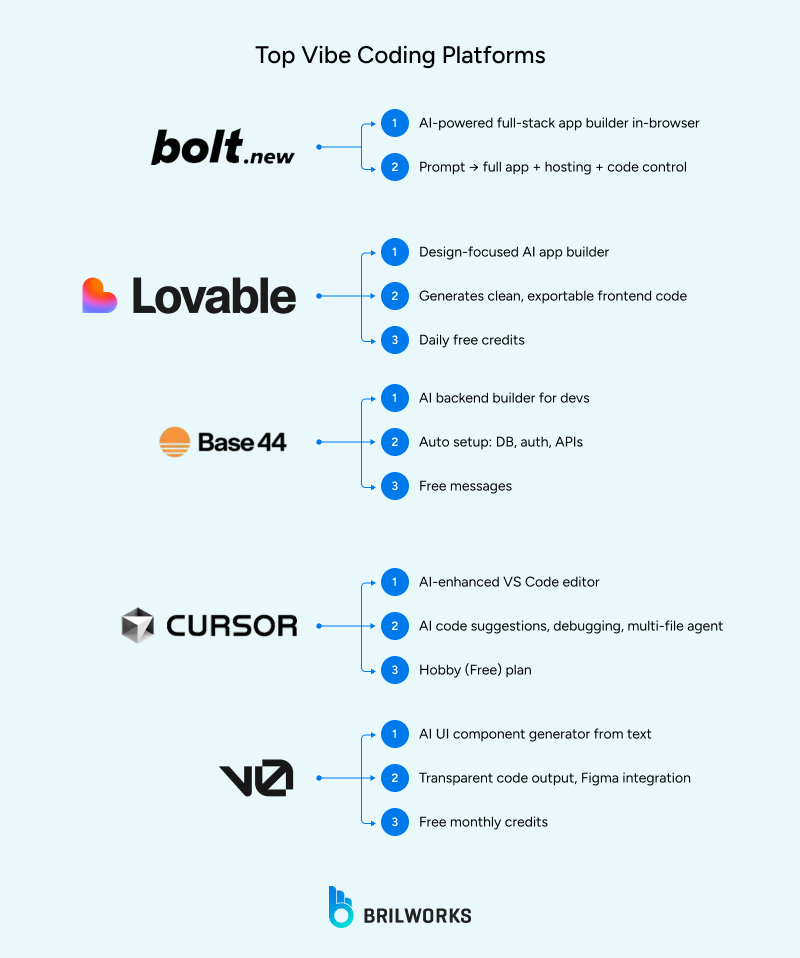
Bolt.new is an AI-powered web development agent that lets you prompt, run, edit, and deploy full-stack applications directly from a browser. This tool is great for innovators who want to build a full-stack proof-of-concept without any local setup.
Core Capabilities: It excels with a "Prompt-to-App" workflow that generates an entire app from a single prompt. It also includes integrated hosting and a command terminal. A major advantage is full code control, so you can edit and deploy the AI-generated code.
Pricing: Bolt has a free plan with a limit of 2.5 million tokens per month. The Pro plan is $25/month for 10 million tokens and no daily limits. The Teams plan is $30/user/month.
Lovable is an AI-powered app builder with a strong focus on generating clean, usable code and a great user interface. This is the go-to platform for designers and product managers aiming to build functional prototypes with a polished look.
Core Capabilities: Users praise its "design-centric generation," which excels at creating visually appealing frontends. It generates reusable code blocks and boilerplate, and the code can be exported to GitHub.
Pricing: Lovable has a Free plan with 5 daily credits and a cap of 30 monthly. The Pro plan starts at $25/month for 100 credits, and a Business plan starts at $50/month.
Base44 is a platform that specializes in building the backend logic and integrations for an application. This platform is made for developers and technical founders who need to quickly set up a backend without writing boilerplate.
Core Capabilities: Its "AI-Powered Backend" automatically sets up a database, user authentication, and API endpoints. It uses a credit system for transparent cost management.
Pricing: Base44 has a Free plan with 25 message credits and 100 integration credits per month. The Starter plan is $20/month, with higher-tiered plans like Builder at $50/month and Pro at $100/month.
Cursor is an AI-first code editor designed to accelerate development. It's a fork of VS Code with AI capabilities integrated directly into the editing process. This tool is for professional developers who want a deeply integrated AI assistant for complex, multi-file tasks.
Core Capabilities: It offers AI-powered code improvement suggestions and a powerful "Agent" feature for multi-file tasks. It can debug code and provide context-aware suggestions.
Pricing: The Hobby (Free) plan has limited AI usage. The Pro plan is $20/month with unlimited use of the "Auto" model and a $20 credit pool for premium models. The Teams plan is $40/user/month.
v0 by Vercel is an AI-powered code generator that creates UI components and app sections from text prompts. It’s known for having the most transparent and technical vibe of all the tools, as it shows you the code it's generating every step of the way. This is the perfect tool for frontend developers who need to generate reusable UI components and sections quickly.
Core Capabilities: It’s built on Vercel's platform, providing a seamless deployment experience. It integrates with Figma and allows for visual editing in "Design Mode." Users can also access the v0 API to integrate it into their own applications.
Pricing: The Free plan includes $5 of monthly credits. The Premium plan is $20/month with $20 in monthly credits. The Teams plan is $30/user/month with $30 in credits per user.
Adopting vibe coding is not a simple flip of a switch. Companies that want to integrate this new paradigm must develop a phased roadmap. A hybrid approach, where traditional coding and vibe coding coexist, is the most practical and effective strategy. Here is the roadmap for companies looking to transition to a vibe coding-augmented workflow.
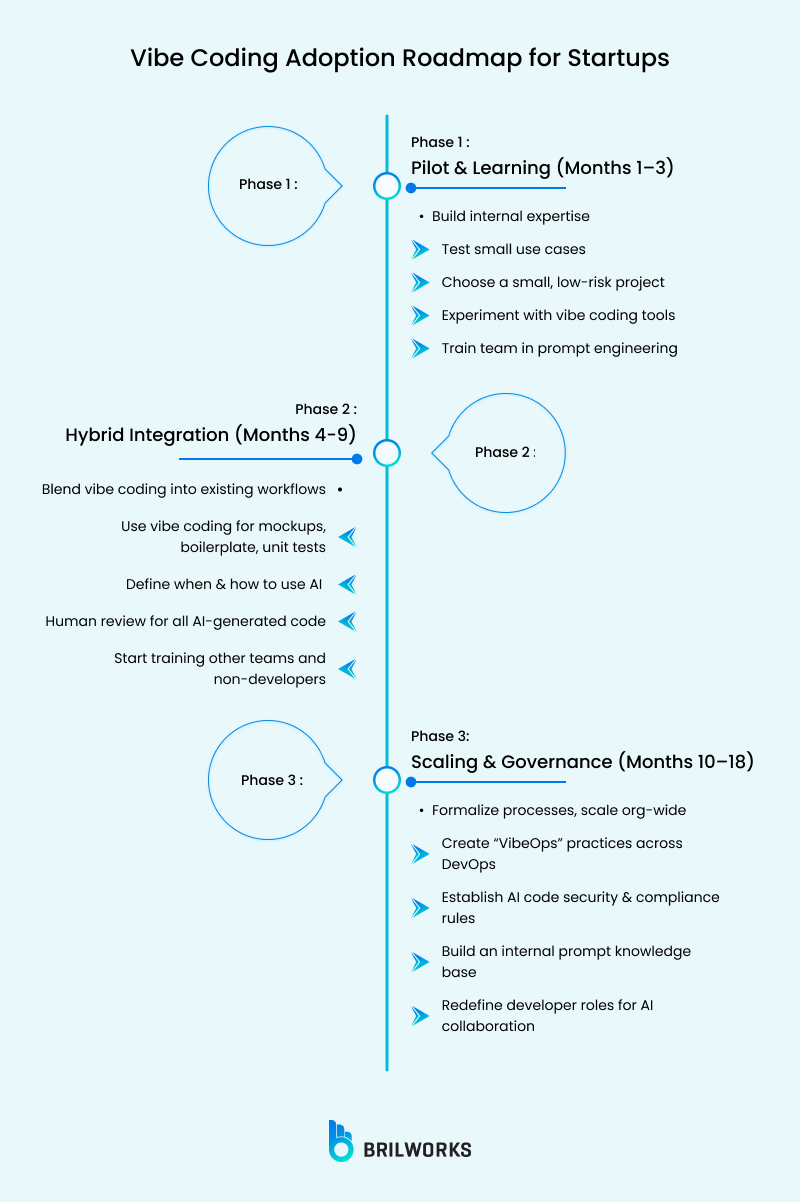
Goal: Understand the capabilities and limitations of vibe coding in a controlled environment. Build internal expertise and identify use cases.
Form a Vibe Coding Task Force: Create a small, cross-functional team (e.g., one or two senior developers, a product manager, and a QA engineer) to lead the initiative. Their role is to experiment, establish best practices, and document their findings.
Select a Pilot Project: Choose a non-critical, self-contained project with a clear, small scope.
Choose & Equip the Team: Provide the task force with access to top-tier vibe coding platforms and AI assistants (e.g., Cursor, GitHub Copilot). Encourage them to experiment with different tools to find the best fit.
Train in Prompt Engineering: The task force should focus on developing the new core skill of "prompt engineering" through workshops and hands-on practice. They must learn to frame prompts to get secure, maintainable, and well-structured code.
Goal: Scale the learned practices and integrate AI-assisted workflows into existing development processes.
Integrate Vibe Coding into the SDLC: Define clear guidelines for when and how to use vibe coding.
Vibe coding becomes the standard for initial proof-of-concepts and mockups. Developers can use it for generating boilerplate code, writing unit tests, refactoring, and adding documentation. However, all AI-generated code must go through a human-led review process.
Update Code Review & QA Processes: Introduce a new step in the pull request (PR) process specifically for AI-generated code.
Implement a "Human-in-the-Loop" Policy: Establish a clear rule that no AI-generated code can go into production without a thorough human review. This is the most crucial safeguard against technical debt and security risks.
Start Cross-Team Training: The pilot team should now train other developers and even non-technical employees (e.g., "citizen developers") on the basics of vibe coding, focusing on practical use cases relevant to their roles.
Goal: Establish a long-term strategy, create a formal governance framework, and scale the hybrid model across the organization.
Establish VibeOps: Define a new set of practices—VibeOps—that integrates AI into the entire DevOps pipeline.
Develop a Security & Compliance Framework: Formalize rules for data privacy and intellectual property. Ensure that the AI tools used comply with enterprise-grade security standards and that any code trained on proprietary information remains secure.
Invest in Continuous Learning: Create an internal knowledge base of effective prompts, use cases, and lessons learned. Encourage developers to share their experiences and help each other get the most out of the tools.
Refine the Talent Strategy: The role of the developer will evolve. Instead of focusing solely on writing code, they will become AI orchestrators—experts in system architecture, advanced problem-solving, and human-AI collaboration. Update hiring and training programs to reflect this new skillset.
By following this roadmap, a company can successfully navigate the transition.
Vibe coding introduces new ways to build software using AI tools and prompt-based workflows. It requires thoughtful adoption, clear practices, and the right people.
As more teams begin experimenting with this approach, especially for early-stage products, it's becoming clear where it adds the most value — fast-moving builds, lean teams, and AI-aware development environments. That’s why many startups and product teams are now looking to hire AI engineers for mobile development, web apps, and other use cases where speed and flexibility matter.
Get In Touch
Contact us for your software development requirements
Get In Touch
Contact us for your software development requirements